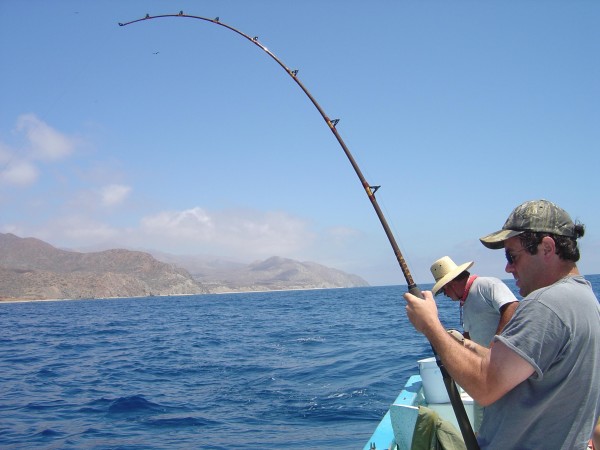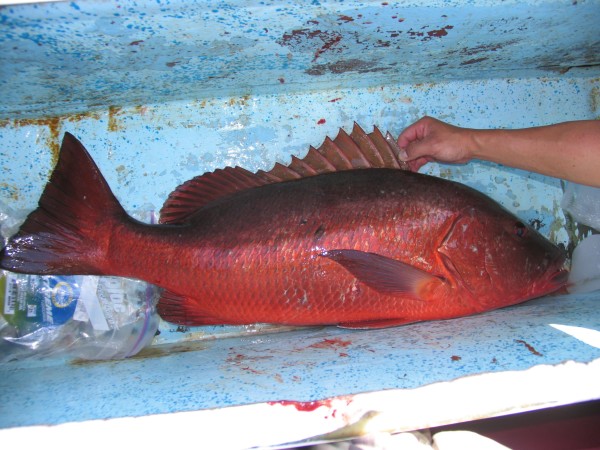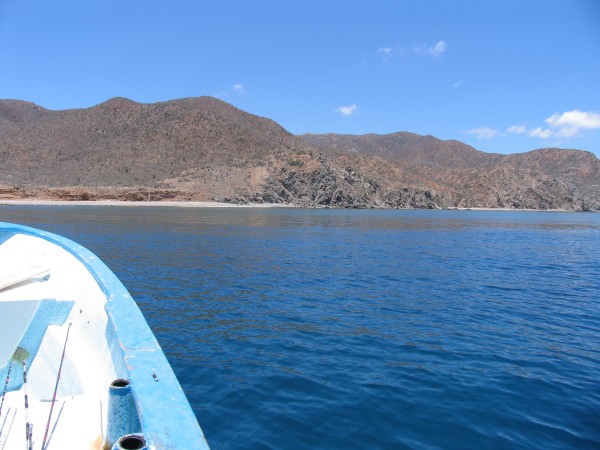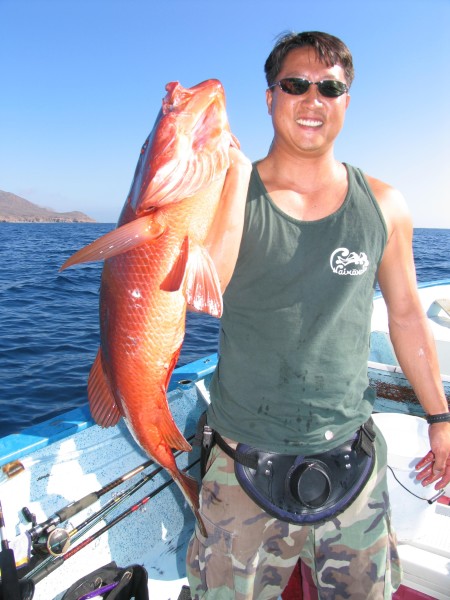Obsessed With Snapper In Baja
Editor’s note: The following appears in the July issue of California Sportsman:
Photos and Text By Tim E. Hovey
I first met my friend John Smith at the back of an organic chemistry class while we were both in college. He was easy to spot in the early-morning class, dressed in his pressed ROTC uniform. He’d walk in a few minutes late, weave his way to the back of the class, take a seat and promptly fall asleep.
Within months of our first meeting, John and I were traveling the roads of Baja California and fishing for science. At the end of that first year we were both part of an elite fishing group that flew down to La Paz to catch specimens for research projects. For a couple of college students who loved to fish, it was a trip of a lifetime.
THE FIRST MORNING of the trip, we gathered at the beach of Los Arenas and climbed into our assigned pangas. We fished hard for three days and enjoyed every single minute. We caught species we had never even seen before and landed a handful of game fish. It was during this fishing trip to La Paz that we first encountered the pargo.
The name pargo is a general description given to describe several species of snapper inhabiting the Gulf of California. While there are over a half-dozen different species of true snapper that anglers can catch in Baja, the two giants that probably garner the most attention are the dogtooth snapper and the mullet snapper.
At the end of our first day of fishing, while most were offloading dorado and tuna, John and I were drawn to a boat at the edge of the fleet. The captain had tossed two large fish in the sand near the shore. The bright reddish-brown fish were strikingly different in appearance than the other game fish. The smaller of the two was a 30-pound dogtooth snapper. The fish was over 3 feet long, dark red with shades of brown and a mouthful of large canine teeth. The side of the fish was scarred up, the result of having lost the battle to escape to the rocks.
The second species in the fillet pile was larger than the dogtooth and was an indescribable shade of red. It had huge yellow eyes, scales the size of a silver dollar and a tail wider than a broom. This was a mullet snapper, and John and I were fascinated.
When you come to such an amazing angling location as La Paz, you most certainly want to tangle with the more popular game fish that cruise the Sea of Cortez.
During the drive back to the hotel, fishermen talked of catching dorado, tuna, sailfish and marlin. While I listened to stories of who caught what, all I could think about were the two red fish lying in the sand.
As the trips to Baja piled up, John and I started to learn just how tough these two species of snapper were to catch. The mullet snapper has incredible eyesight and shies away from larger hooks and thicker line. During peak times of the year, huge schools of this species will gather and tease fishermen as they rise to the surface in huge red balls – only to shun most offerings – and then sink below the surface and disappear. I called them the red ghosts.
The dogtooth snapper uses brute strength, savage teeth and rocky caves to elude fishermen. Often hooked on trolled live baits, they’ll grab the lure with an explosive surface take.
In the seconds that follow, the hooked dogtooth snapper will head for the rocky caves to escape. Unprepared anglers unable to overcome the strength of the escaping fish will be left with dashed hopes and frayed lines. To John and I, these two species definitely represented the highest angling challenge of Baja.
IN 2008, WE planned a trip to La Paz to fish the azure blue waters off the coast of Los Arenas. We booked a three-day fishing package and arrived with high hopes. Unfortunately, the first two days of fishing were extremely slow. We searched the usually very fishy waters around Cerralvo Island and fished hard those first two days, only to return to the beach with empty fish boxes.
On day three, we headed to the offshore island to catch bait. Once the hold was full, John and I decided that we should try trolling for dog snapper. Ending the trip by chasing the big red monster of the gulf was fine with me.
We rigged up the large trolling rigs, baited them with whole ladyfish and dropped the bait behind the boat. The captain guided the panga around the perimeter of the island in about 60 feet of water. Liquid shadows and large dark shapes were visible in the clear water below. We were in the right place, with the right bait, and we were ready.
After two passes with no action, the captain was swinging wide for a third pass when a large and violent splash erupted behind the boat. Less than a second later, John’s rod bent sharply, and even though the drag was tightened down, the reel began to scream.
John realized that the next few seconds would decide who won this battle. He grabbed the rod, leaned back hard and squeezed the reel to slow the escaping line. Seeing the strike, the captain simultaneously pointed the panga toward open ocean, assisting in fighting the fish with the boat.
For the first minute, it was a stalemate. The fish’s enormous tail pulled hard against the drag, the rod and John. No line was given and none was retrieved. And then the battle turned. John grabbed the handle and took three quick turns, gaining a few feet. The captain again gunned the panga for open water and John gained a few more feet.
With the fish tiring and the jagged rocks out of play, John fought the large red fish back to the boat. With one last lift, John’s first and last fish of the trip came to gaff. You likely could’ve heard our celebration back at the launching beach, 7 miles away.
During the fight, we had drifted off the island and we were just about to run back in to troll our last big bait, but then the red ghosts appeared. A large red cloud rose to the surface about 40 yards away. I grabbed my 30-pound outfit, already rigged with a small bait hook, put on one of the smaller baits and tossed my rig into the center of the cloud.
At first, absolutely nothing happened. The small baitfish darted around and then began to dive, looking for cover. I was watching the line as it twitched and then began to move. I let several seconds pass as line peeled off my reel. I then locked it up and set the hook.
Despite living in the same environment, the hardest part about catching a mullet snapper is getting them to bite. They rarely try to escape into the rocks and if you can fool their incredible eyesight and keep them hooked, the battle can tip in the angler’s favor.
As soon as the fish felt steel, the red cloud dispersed. The hooked snapper took off and peeled line off for 45 seconds before easing up. I could feel him thumping his broom-like tail trying to escape. I kept the pressure on, but with every line gain, the fish would take double that back as he headed for deeper water. The captain looked at me and said, “Grande pargo!”
We were now a mile from the island, and even though the school had been less than a foot from the surface when the snapper took my bait, none of us had seen the hooked fish. My rod continued the rhythmic thumping as the snapper kept fighting. All I could think of was a hook that could easily fit on a dime was the only thing connecting me to this fish.
I finally began gaining line and could feel that the fight was about over. John looked over the side and saw the large snapper on its side 20 feet below.
“Dang, that’s a nice one!”
With a final pull, my first and last fish of the trip, a huge mullet snapper, was gaffed and heaved over the side.
AFTER A FEW photos, the bright red snapper was added to the fish box alongside John’s beast. We fished hard that last day, but the two red fish were all we caught.
That didn’t matter to us. Back on shore, we walked the sand beach among the other pangas to see what others had caught. It was clear that the last few days on the gulf had been slow.
Back at our boat, two other captains were admiring our catch of the day. A few years earlier, John and I had been on this same beach when we first encountered the red giant. After a few trips, we finally figured out the techniques and caught two nice specimens of pargo ourselves.
I love fishing the Sea of Cortez. I’ve caught all the popular big game species available over the years, but photos of John and I with our large red fish remain some of my favorites. To share a boat with a good friend and fish the pristine waters of Baja will forever be some of my fondest memories. CS








